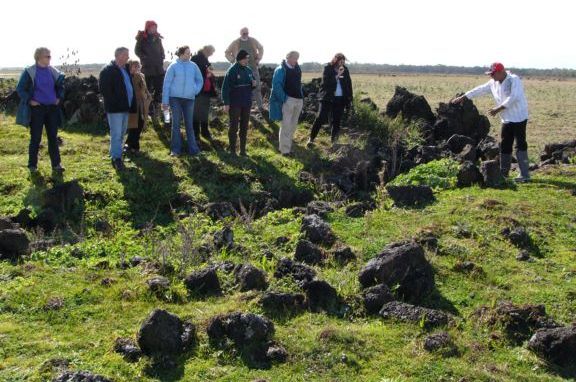
Aboriginal Heritage
Aboriginal people did not just coexist with the environment, but worked with it sustainably for many thousands of years. The majority of their diet came from berries, leaves, seeds and roots. Plants were also used to produce baskets, shelter, weapons, canoes and fish traps. Aborigines were also aware of the medicinal properties of some species.
Aborigines were nomadic in arid areas of Australia, but the abundance of freshwater, plants and wildlife in south-west Victoria enabled clans to settle and build stone dwellings and complex fishing systems.
They lived in permanent settlements; obtaining sustenance, expressing themselves artistically, passing on creation stories and cultural values, engaging in conflict, establishing alliances and social networks, trading goods, celebrating rites of passage and committing the departed to their final resting places.
This led to as many as 400 clans and language groups being established in Victoria with complex but well-defined beliefs and kinship systems. Clan size ranged from less than 50 to many hundreds. The knowledge of culture and custodial responsibilities to the land, its spirits and the ancestors were passed on through story-telling, rock paintings and ceremonial dances.
Aborigines had to contend with the last mini ice age, volcanic eruptions extending across south-west Victoria from Melbourne to Portland and global warming that cut Tasmania off from the Australian mainland.
Trade routes across Australia were an important part of Aboriginal social, spiritual and economic life. Trade between neighbouring clans stimulated social interaction with other tribes which led to the sharing of stories and news.
Trade routes criss-crossed Australia with bartered goods that could only be obtained from specific geographical areas travelling from one end of the country to the other. Respect, knowledge of required laws and cultural protocols were all part of the complex interactions involved in these trade journeys.
Melo shell from north-east Queensland was traded all the way to South Australia while Flinders Ranges ochre was carried as far as central Queensland.
According to Ballarat academic, Ian D. Clark in Aboriginal Languages and Clans: An Historical Atlas of Western and Central Victoria 1800-1900 there was a distinct geography of Aboriginal occupation and ownership, as well as many languages and dialects.
The 600 Aboriginal clans within Australia spoke 200 different languages. While the languages of clans within close proximity were generally mutually intelligible, they gradually differentiated into separate language as the distance between the clans grew.
It was believed that many of the languages of the Aboriginal people in south-west Victoria had been lost, but they are being rediscovered in records, archives, place names and through the determination of Aboriginal people to reclaim their heritage.
|